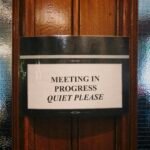Why I Went Silent
In our fast-paced, hyper-connected world, the endless stream of communication can take a significant toll on mental well-being. The decision to stop talking for 72 hours was driven by an acute realization of my own burnout—a sensation that had quietly crept into my life over time. With the rise of digital connectivity, the expectation to be constantly available and engaged has intensified, leading to feelings of overwhelm that are increasingly hard to ignore.
Reflecting on my personal experiences, I found myself indulging in a near-obsessive reliance on technology for communication. Instant messaging, social media notifications, and emails flooded my day-to-day life, leaving little room for silence or introspection. Instead of providing a sense of connection, this barrage of constant interaction led to mental fatigue and diminished emotional clarity. I often felt drained at the end of the day, as if the effort to maintain relationships and dialogue had extracted more energy than it should have.
Moreover, stress had become a familiar companion, manifesting in various forms—ranging from anxiety to difficulty concentrating on tasks that once brought me joy. The incessant noise of everyday chatter further complicated these emotions, often drowning out my inner voice. It occurred to me that in the pursuit of staying engaged with friends and family, I had neglected the importance of self-reflection and solitude.
By opting for silence, I sought to reclaim my mental space and rediscover my thoughts without the interference of others. It was an experiment aimed at alleviating stress, reducing the clamor of my environment, and allowing me to assess the impact of digital communication on my mental health. This opportunity for introspection soon revealed surprising insights about my habits and the importance of balance in our interconnected lives.
The Burnout
Burnout has increasingly become a widespread issue, affecting individuals across various professions and life situations. It typically manifests as a persistent feeling of fatigue, emotional exhaustion, and a significant decrease in motivation. When an individual experiences burnout, simple tasks can feel monumental, particularly the act of communicating effectively. This chronic state of fatigue often results in an overwhelming sense of detachment from work and personal obligations. Consequently, interpersonal relationships may also suffer, leading to further isolation.
The signs of burnout can be subtle at first, often creeping up on an individual without warning. Individuals may begin to exhibit irritability or a general disinterest in activities they once enjoyed, including meaningful conversation. This emotional depletion can stem from societal pressures that demand relentless productivity, higher performance standards, and constant connectivity. In today’s hyper-accelerated world, the expectation to be perpetually available and responsive amplifies the sensation of being overwhelmed. This environment makes it easy for one to overlook personal needs, thereby hindering effective communication.
The societal factors contributing to burnout are complex and multifaceted, often encompassing workplace dynamics, personal relationships, and even technological influences. It can create a vicious cycle where the inability to express oneself leads to further isolation and increased feelings of exhaustion. Therefore, recognizing the signs of burnout is crucial for both personal well-being and the ability to engage in meaningful dialogue with others. Understanding this phenomenon provides essential context for the need to take a step back from verbal communication and allows individuals to regain emotional balance and clarity. Moreover, addressing burnout proactively may facilitate more effective communication in the future, ultimately enhancing interpersonal connections.
Communication Overload
In today’s fast-paced, digital world, the phenomenon of communication overload has become increasingly prevalent. With the rise of instant messaging, social media platforms, and constant notifications, individuals often find themselves bombarded by a cacophony of digital interactions. This incessant flow of communication can quickly lead to feelings of stress, anxiety, and burnout, a collective phenomenon that many are beginning to refer to as communication fatigue.
Studies have indicated that the average person receives over 100 notifications per day, including emails, text messages, and social media alerts. This barrage of information can create an overwhelming sense of urgency, often compelling individuals to respond immediately, even when they may not have the capacity to engage meaningfully. According to a report published by the American Psychological Association, 66% of respondents reported feeling overwhelmed by the volume of communication they encounter daily. This statistic emphasizes the dire need to confront the adverse impacts of over-communication in our lives.
Furthermore, the compulsive nature of modern communication tools fosters a culture of expectation, wherein instantaneous responses are often anticipated. This expectation can generate additional pressure, contributing to mental fatigue and even affecting interpersonal relationships. The feeling of being constantly ‘plugged in’ can impede an individual’s ability to concentrate, engage in meaningful conversations, or simply enjoy a moment of silence.
Researchers are advocating for regular breaks from constant connectivity to mitigate these negative effects. By setting aside designated periods of time for communication-free experiences, individuals can recalibrate their minds and reduce feelings of overwhelm. Establishing such boundaries not only promotes healthier communication habits but also fosters deeper, more meaningful interactions when individuals do choose to engage.
The First 24 Hours
The initial 24 hours of my silence experiment proved to be an unexpectedly tumultuous period, leading me to confront a myriad of emotional and psychological challenges. As the hours progressed without spoken words, I found myself grappling with feelings of anxiety and restlessness. The absence of conversation created an eerie vacuum, amplifying my thoughts and making their weight more palpable than ever before. The simple act of not speaking began to highlight the clamor of my usual daily interactions, which became noticeably deafening in retrospect.
During this period, a sense of self-doubt crept in as I started to question my decision to embark on this experiment. This uncertainty was compounded by the realization that communication, particularly verbal, plays a crucial role in my life and daily interactions. Without it, I struggled to connect not only with those around me but also with my own thoughts. The quietude felt suffocating at times, as my mind raced with what seemed to be endless questions and thoughts that I could not express. I found myself yearning for the familiar rhythm of a conversation, the back-and-forth that characterizes social engagement, which I had relinquished.
In this reflective state of silence, it became evident just how much I relied on dialogue to shape my day-to-day existence. The stark contrast between my usual routine, filled with interaction and discourse, and the stillness of this silence experiment was jarring. I noticed how every mundane task began to seem heavier and more significant without the comforting background noise of chatter and laughter. As the first 24 hours concluded, it was clear that this challenge was far more than an exercise in restraint; it was a deep dive into the complexities of human connection and self-awareness in the absence of verbal dialogue.
Painful Silence
The decision to abstain from speaking for 72 hours introduced me to an intense experience defined by profound silence. Initially, this silence felt like an oppressive weight, creating a palpable discomfort that echoed within my mind. It compelled me to confront thoughts and emotions that I had usually avoided through the refuge of conversation and external stimulation. Without the option to articulate my feelings or engage in dialogue, I found myself grappling with a torrent of internal dialogues that surged to the forefront of my consciousness.
As the hours progressed, I recognized the instinctive desire to fill the void with noise. The human tendency to seek connection through speech became starkly apparent; silence, I learned, can be unsettling and revealing. It was as if each thought, no matter how trivial, amplified in the absence of external chatter. The hum of everyday life—whether through social interaction or casual conversation—masked many underlying emotions and reflections I seldom had the courage to address. Stripped of these distractions, I faced my vulnerabilities head-on.
This introspective journey became a poignant exploration of my worries, anxieties, and unresolved feelings. Without the comfort of vocal communication, I was able to delve into deeper layers of self-awareness. Instead of seeking distraction, I learned to embrace the discomfort that accompanied these thoughts. It became evident that acute awareness of my emotional landscape often fostered a more authentic understanding of my inner self. This period of painful silence ultimately transformed from a source of unease to an unexpected catalyst for personal growth, emphasizing the value of facing one’s mind without the crutches of external validation.
Observing More
The decision to embrace silence for 72 hours presented an unexpected opportunity for profound observation. In our daily lives, conversations often dominate our attention, leaving little room for contemplation of the world around us. However, with the absence of verbal communication, I found my senses heightened, enabling me to register details that would typically go unnoticed. The subtle rustling of leaves, the distant chatter of people, and the harmonious hum of nature became prominent features in my auditory landscape. Each sound unfolded a story that my previous distractions had silenced.
This newfound awareness extended beyond auditory experiences. I discovered a deeper appreciation for non-verbal cues in my interactions with others. Body language and facial expressions took center stage, revealing emotions and intentions that words often obscure. For instance, a gentle smile or a furrowed brow communicated emotions more powerfully than any spoken language could. Observing these nuances provided invaluable insights into human behavior and fostered a sense of connection that is often overlooked in the noise of conversation.
Moreover, I became acutely aware of my surroundings. The architecture of buildings, the patterns of light and shadow, and even the textures of objects came alive in a way they never had before. What once seemed mundane transformed into a rich tapestry of experiences, each moment bursting with details waiting to be recognized. This attention to the intricacies of everyday life underscored the notion that silence amplifies perception; it allows us to absorb our environment more fully and to appreciate the often-ignored beauty that it holds.
This experience of silence heightened my overall awareness, revealing a world filled with intricate details and real emotions that I had taken for granted. It is a reminder of the significance of observation and the treasures that lie just beneath the surface, waiting for us to notice them.
Mental Clarity
The journey of not speaking for a full 72 hours brings about an unexpected clarity of mind that is often overshadowed by the noise and distraction of everyday life. When I entered this self-imposed silence, I began to notice a significant shift in my thought processes. The absence of external chatter allowed my mind to settle and promote clearer thinking, leading to sharper insights and heightened awareness of my surroundings. Without the constant influx of conversations, social media notifications, and other interruptions, I was left with only my thoughts, resulting in a profound sense of focus.
During this reflective period, I found myself more equipped to make informed decisions. The quiet allowed me to sift through my feelings, weighing different perspectives without the influence of others’ opinions. As a result, I gained a deeper understanding of my desires and motivations. The contemplative atmosphere fostered by solitude illuminated aspects of my personal and professional life that I had previously overlooked. I was able to pinpoint ambitions that felt lost in the noise and formulate actionable steps that aligned more closely with my true self.
The psychological benefits of this intentional silence were remarkable. Engaging in silent reflection enabled me to process my thoughts more effectively and cultivate emotional resilience. This mental clarity provided a gateway to understanding my values and priorities, allowing me to draw connections between my experiences and aspirations. What became evident was not just the power of silence but the realization that stepping away from the external world can enhance one’s inner landscape. Embracing solitude for a short period can lead to transformative insights about one’s self, ultimately nurturing a foundation for personal growth and fulfillment.
Lessons Learned
The 72-hour silence experiment proved to be a profound period of reflection, imparting numerous lessons related to communication and self-awareness. Initially, the absence of verbal communication felt daunting, yet it quickly transformed into an opportunity for deeper introspection. Without the ability to engage in conversation, I became acutely aware of the myriad non-verbal cues often overlooked in daily interactions. Body language, facial expressions, and even silence itself emerged as powerful tools for communication, drawing attention to how emotions can be conveyed without uttering a single word.
This experience underscored the importance of active listening, a skill that tends to diminish amidst the hustle of everyday life. Without the option to contribute verbally, I focused entirely on others, interpreting tones, gestures, and silences. I recognized how often I was distracted during conversations, thinking about my next response rather than fully engaging with the speaker. The lesson here is clear: taking a step back to listen can lead to richer and more meaningful exchanges, enhancing both personal relationships and professional interactions.
Moreover, the experiment illuminated the necessity of taking breaks—not just in communication, but in life in general. The silence allowed for mental clarity and fostered a sense of peace that is often overshadowed by the incessant noise of our environment. This pause offered me time to process feelings and thoughts, revealing insights that typically remain buried in the constant whirlwind of everyday chatter.
Ultimately, the silence reshaped my approach to talking and listening. I emerged from the experiment with a renewed appreciation for the value of both speech and silence, understanding that each has its place in effective communication. By striking a balance between the two, I aim to foster deeper connections with others and to enhance my overall mindfulness in interactions.
Applying Silence in Daily Life
In our fast-paced world, the incessant noise of communication can often lead to feelings of overwhelm and anxiety. Incorporating moments of silence into daily life can significantly enhance our relationship with both communication and personal reflection. Here are some practical tips for embracing silence effectively.
Firstly, consider integrating silent moments into your routine. This can be as simple as taking a few minutes each morning to enjoy a quiet cup of coffee or tea before starting your day. Use this time to reflect on your thoughts or set intentions for the day, which allows for a mindful approach to communication and interaction. Engaging in early morning solitude can foster clarity and prepare you for the conversations ahead.
Secondly, during designated times throughout the day, consciously pause before responding in conversations. This moment of silence not only helps in formulating thoughtful responses but also demonstrates active listening. It can transform the dynamics of communication, as it shifts the focus from merely reacting to genuinely understanding the other person’s perspective. Practicing this can also mitigate feelings of overwhelm, as it encourages one to engage more intentionally in dialogue.
Moreover, explore the concept of tech-free periods. Allocate specific times when you disconnect from digital devices, allowing for undistracted moments of silence. This practice not only cultivates a more profound connection with yourself but also promotes a more balanced communication style when you re-engage with others. You may find that communication becomes more meaningful and less frenetic.
In addition, consider maintaining a journal or engaging in reflective writing. This exercise creates a space for silence in thought, facilitating deeper self-analysis and comprehension of your feelings regarding communication. Through continued practice, you will likely develop a healthier relationship with both silence and conversation.

It could cover a range of topics related to health, wellness, beauty, personal growth, and social issues, all from the perspective of striving for beauty, intelligence, youthfulness, and impartiality





